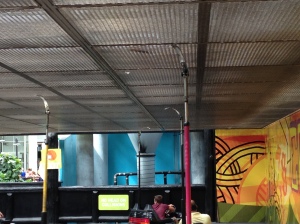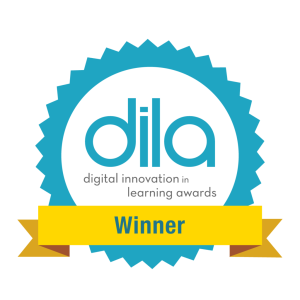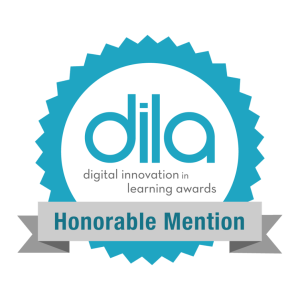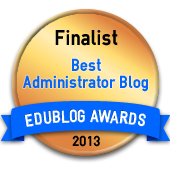Blog Archives
My Pastor was Right. Again.

So a funny thing happened a few years ago. I was sitting in church and our pastor at the time, Steve Wiens, started talking about neuroplasticity. I’ve always been a big nerd at heart, so I immediately took interest. Actually, I was totally eating the science up and loving every second of it. The truth of the matter is that Steve’s message helped me overcome some gunk in my life, and it’s a message I still carry with me when reflecting on change, innovation, and education.
In a nutshell, here’s what I gleaned from Steve’s sermon. We all have habits, tendencies, or even addictions that have become hard-wired into us. Some of these habits are good (holding the door for others, showering, and saying “thank you” are a few examples). Other habits are not so good. In fact, they can be downright destructive (fill in the blank with whatever unhealthy habit or failed New Year’s resolution you have here). If you’re an advanced learner or high-flyer you’re already connecting my sermon notes to education…but try to live in the moment and bear with me one more paragraph.
Our pastor likened these tendencies to footpaths formed in the snow. (I live in Minnesota mind you, so I hope you’re envisioning a lot of snow and very deep footpaths!) The more we travel a path, the easier it becomes to travel. Conversely, forging a new path can be extremely challenging. The first few times through the snow are always the toughest. In fact, it can be so difficult to take a new path that we might choose to revert down the same old path even when we recognize it is no longer the right direction in our lives.
Now on to the neuroscience of educational change. Creating new neurons involves linking something new to existing schema. (Remember, you can’t do this without a new path.) You’ve got to walk differently, practice, and persevere. So how might we link best practice to innovation in education? How do we connect the two in a manner that is “walkable” for others? What does that path even look like?
I believe that we’ve reached a point in education where we are collectively capable of giving kids more than they are currently receiving. All kids deserve innovative schools and I’m not okay with the fact that not all kids are experiencing this. There’s more work to do!
How do we get rid of some of the educational gunk (a.k.a. past tendencies, habits, etc.) and form some new dendrites? (See what I did there with the dendrites thing?!) I propose that we start by taking the first step. And then the next. Here are a couple examples so that this is not pure hyperbole:
- We know that students deserve redesigned learning spaces that support the 21st-century skills they’ll need…so we should take the first step in making it happen within our own sphere of influence (classroom, school, district, etc.)
- We know that we cannot be the experts of everything, and that connecting with other educators regardless of time/proximity only makes sense…so we should take the first step in helping a colleague on this path. We need to get more people connected so we can better serve our students.
Thinking different requires different steps. Different doing. And it is possible! My pastor was right.
_
Yes! This blog is moving to a new home. Hop over to www.BradGustafson.com to see how the Adjusting Course blog looks “all grown up.” I’d love your feedback on the new site too.
1 Page Dissertation
 This past week a friend shared his doctoral findings on Twitter in a single-slide summary. I thought the idea was brilliant. The simplicity of a single graphic can be a great catalyst for conversation and reflection. At the same time, it can potentially over-generalize by removing important context about the research methodology. My research involved some of the most innovative elementary principals in the country, and they do not necessarily represent all elementary principals. Click HERE to access my entire dissertation.
This past week a friend shared his doctoral findings on Twitter in a single-slide summary. I thought the idea was brilliant. The simplicity of a single graphic can be a great catalyst for conversation and reflection. At the same time, it can potentially over-generalize by removing important context about the research methodology. My research involved some of the most innovative elementary principals in the country, and they do not necessarily represent all elementary principals. Click HERE to access my entire dissertation.
*Hat tip to Tony Sinanis for the idea to make a 150+ page published research document more accessible to others!
Flipped School Board Meeting
Background Information: We believe that the most important voices in a school are those of its students; they are central to our mission. The purpose for highlighting pedagogy via video is to amplify student voice when we are together in person. We want the walls of the Wayzata City Hall to reverberate with authentic student sharing and stories about their learning experiences at Greenwood Elementary.
Providing content prior to a lesson or presentation is often referred to as “flipped” instruction. We’re applying the same basic principles to maximize our face-to-face time and to facilitate deeper conversation at the School Board meeting. Please watch our five minute video before April 13.
Focus: Meaningful Technology Integration
Learning Targets:
- I can identify at least two approaches teachers are using to help students discover their unique talents.
- I can evaluate how students are experiencing a “connected pedagogy” by articulating how technology is being used to transform learning in order to prepare students for their future.
School Board Presentation Agenda
Students will share two-three minute presentations with the support of their teachers. A copy of the PowerPoint we’ll be using is below.
- Sphero Robotic Droids featuring students taught by Carrie Lunetta & Joe McAuliff
- Mobile MakerSpace Carts featuring students taught by Ginny Adams
- Genius Hour featuring students taught by Joe Vrudny & Elle Zeman
- 3D Printing featuring students taught by Adam Hinnenkamp
- Drone Technology featuring students taught by Madeline Ray & Brad Gustafson
- EPIC Reading featuring students taught by Ashley Drill & Jamie Tewksbury
- Question & Answer Time facilitated by Greenwood students and staff
Additional Resources:
- Click HERE to view a “Flipped Leadership” book by Peter M. DeWitt.
- Hashtags on Twitter to Explore include: #ThatsMyCube, #GWgreats, and #EduDroneChallenge.
- Watch an astounding TED Talk about the athletic powers of quadcopters.
- Video Resources specific to Greenwood include: Mobile MakerSpaces, Genius Hour, ConnectED BINGO, and Sphero Droids.
Connected Learning
Our mission is to plan Professional Development (PD) opportunities that are so responsive that every single teacher walks away from their breakout session-choice feeling empowered. Each month’s focus will align with one of our three building goals:
1.) High Student Achievement in Literacy
2.) Meaningful Technology Integration
3.) Relationships and Culture
HUGE shout-outs to our PD Chair, PD team, and our site data team. Your time and leadership has us in a great position to focus our efforts while continuing to learn and grow.
Our first round of staff PD Breakout Sessions will be Monday, October 27th and the focus will be technology. The session options below were planned based on staff feedback collected using the “Empowered Learning” forum in Moodle last spring. Sign-up for each session can be done online and Continuing Education Credits (CEUs) are available.
Session 1 (Flipped)
Connecting with Classrooms across the Country
Guiding Question: How might we teach students to connect and share responsibly? We’ll respond to the video and discuss the pedagogy & tools to connect kids to an authentic audience. We will also participate in a GHO video-conference with a school in another state. Please view the five minute “flipped PD” video prior to our session.
Session 2
Twitter 101: Getting Started…Getting Connected
Guiding Question: What is Twitter and how are educators leveraging it to connect and share? Learn the basics of Twitter like how to Tweet, basics of the bio, and the art of the hashtag. There will be a time for collaboration and assistance in setting up a Twitter account at the end of the session.
We’re looking forward to experiencing many teacher-led sessions facilitated by our very own #GWgreats over the course of the school year. This year we are also piloting an approach to making our monthly PD breakouts OPTIONAL for staff. If you’d prefer to engage with a monthly theme in a different way than what we have planned, we want to empower you to do so. Own your learning! Attend an EdCamp, organize a cross-grade collaborative conversation, observe a colleague and try something new.
A special thank you to the connected educators from across the country that took time to share a short video clip about how/why they are connecting. They’re listed below in order of appearance. I have learned so much from these educators, and encourage you to follow them all on Twitter:
Pernille Ripp | @pernilleripp
Natalie Hull | @misshulljse
Adam Welcome | @awelcome
Erin Klein | @kleinerin
Penngrove Elementary Staff | @mrsnewman014 @msjanuleski @mcandersen88 @ohsposato @mrsfadeji
Brian Costello | @btcostello05
Celeste Mayhood | @celesteclm
John Fritzky | @johnfritzky
Justin Schleider | @schleiderjustin
Becca Bailey | @artwithbailey
Eric Sheninger | e_sheninger
Heather Cooper | @hcooper815
Shelly Roche | @mrsrochejse
Kory Graham | @tritonkory
Jeff Bradbury | @teachercast
Kimberly Hurd | @khurdhorst
Ashley Drill | @mrsdrill3rd
Jamie Tewksbury | @mrstewksbury3rd
Tony Sinanis | @tonysinanis
Maximum Impact
There’s no other way for me to say this…being a Connected Educator has transformed my life and thinking. Using tools like Twitter and Voxer to collaborate with people across the planet has been one of the most exhilarating and humbling endeavors of my life. The energy and co-mingling between my Personal Learning Network (PLN) and colleagues at school helps me deliver a maximum impact for kids.
At a recent family trip to the Mall of America, I was struck by the obvious reliance a bumper car has on the network of metal grates in the ceiling; my PLN is like an unceasing and conductive ceiling constantly sparking my learning.
The AMAZING staff and team we have at our school fuels a collective effort to make a difference for each and every child…together we’re able to handle the bumps and detours that are inherent in any innovative learning organization.
Most bumper cars rely on a conductive floor AND ceiling (each with differing polarities). The pole at the top of a bumper car touches the ceiling, while the contacts on the floor complete a powerful circuit. The resulting connection is rather effective…and tons of fun!
- Where do you get your energy and “spark” from?
- How are you able to make a maximum impact for kids each day?
- How do you remain relevant?
- Who inspires you to collaborate and grow?
We need to be constantly evolving and growing because our students’ world is changing. Our kids deserve relevant educators. There’s a world of collaborative educators out there willing to help…be sure to complete the circuit!
It’s On!
I was recently invited to participate in a blogging challenge. Terri Eichholz threw down the gauntlet and I can’t resist a good challenge (especially when it involves collaboration and my own professional learning).
The premise of the challenge is to name a practice or idea that I adapted from somebody in my PLN, and to follow-up by challenging three more educators to do the same. My response is a resounding, “It’s on!!”
The ideas that I “borrowed” actually came from ten different educators and highlight the power of collaboration made possible via Twitter. You see, each of these ten AMAZING people from across the country shared three mini-challenges designed to help other educators hone their technology skills.
All of this sharing culminated in an epic PD opportunity for you. The ten educators helped create the “Digital Leadership Challenge.” Click HERE to read the mini-challenges. I encourage you to participate with us by working your way through any of the challenges over the next several months.
As part of the #LMSChallenge, I’m passing the torch to three (3) groups:
1.) The ten original collaborators on the Digital Leadership Challenge
2.) The 80+ educational leaders that have signed-up already to participate and grow their Digital Leadership
3.) The Minnesota Elementary Principals Association #MESPAmn
I challenge educators in these groups to blog about an idea they implemented or adapted from somebody in their PLN and post it to Twitter using the hashtag #LMSchallenge. Whatever you do, don’t forget to join us in taking the Digital Leadership Challenge. Sign-up HERE and choose which of the 33 mini-challenges you’ll participate in. This is personalized PD on steroids, and we’ve got a great group collaborating on the challenges.
Make it a great day…and NEVER stop learning!
What a Summer!!
This has been one of the most professionally rewarding summers I’ve had in a long time. I’m taking some doctoral classes and have been immersed in some rich dialog and learning with some really neat friends and colleagues at Bethel University. Our journey together as researchers has spanned three summers now, and the cohort I’m in has been a blessing.
I’ve also begun to expand my Professional Learning Network (PLN). The teachers, administrators and authors I’m learning from have made me a more connected principal. It’s been an amazing adventure and some of the educational technologies that I’m most excited about right now would not even be on my radar if it weren’t for my PLN.
Best of all, I’m able to take some of the innovative tools that I come across and share them with staff members at our school who are also exploring areas of passion. Together we are really integrating some neat ideas and opportunities for students in our school!
Without further ado, here are my (current) favorite educational technology tools:
1.) Twitter. Connect, learn, grow, share, rinse & repeat. Need I say more? Hands down the biggest difference maker for me as a reflective and connected principal.
2.) Aurasma. Although I’m just scratching the surface of Augmented Reality (AR) apps, this one is a keeper! It has ignited my imagination and the power of AR to bolster student creation, imagination, excitement, communication and creativity is limitless. I originally entertained thoughts that this app may just be a glorified QR code generator, but it’s so much more. To see a VERY basic example of what Aurasma can do check out my AR Resources page on this blog (second tab).
 3.) TouchCast. Got communication? This app has all the bells and whistles you’d ever want to start creating your own podcasts. Best of all….it’s easy to learn and has a very professional aesthetic. I’ll admit my first TouchCast was an epic fail, but sometimes that’s where the best learning occurs. If you’ve ever pondered replacing a traditional classroom/school newsletter with an interactive podcast that’s intuitive and fresh TouchCast is a MUST SEE. Love. This. App.
3.) TouchCast. Got communication? This app has all the bells and whistles you’d ever want to start creating your own podcasts. Best of all….it’s easy to learn and has a very professional aesthetic. I’ll admit my first TouchCast was an epic fail, but sometimes that’s where the best learning occurs. If you’ve ever pondered replacing a traditional classroom/school newsletter with an interactive podcast that’s intuitive and fresh TouchCast is a MUST SEE. Love. This. App.
 4.) Smule (Auto Rap). Ever wish you were a rap star? This speech converter is my wife’s nemesis! A principal named Curt Rees shared this one with me, and I spent the better part of a day creating school related rap songs with my three young kids. Can you imagine the creative potential in an elementary classroom? Instead of a summative assessment at the end of a unit, how about a solid rubric and Smule’s Auto Rap App?!! PS – Here’s a sample off my kids’ first solo album: http://khush.smule.com/autorap_52195b7a1902c&v2
4.) Smule (Auto Rap). Ever wish you were a rap star? This speech converter is my wife’s nemesis! A principal named Curt Rees shared this one with me, and I spent the better part of a day creating school related rap songs with my three young kids. Can you imagine the creative potential in an elementary classroom? Instead of a summative assessment at the end of a unit, how about a solid rubric and Smule’s Auto Rap App?!! PS – Here’s a sample off my kids’ first solo album: http://khush.smule.com/autorap_52195b7a1902c&v2
5.) WordPress. I really enjoy writing, reflecting and sharing. WordPress has been a fun new tool to connect with others and document some of my own learning as a school leader. (Thanks for reading this blog by the way.)
“Connected” Principle #1: Be Your Best Pineapple
If you’ve ever tried to be somebody you are not…this blog post is for you. If you’ve tried to do every cool thing found on Pinterest or Twitter in the same school-year…keep reading. And, if there’s anybody in your Professional Learning Network (PLN) that you want to be more like….you’re not alone. Aspiring to grow and develop as a reflective practitioner is important.
In many respects, growth and change are NOT optional. We cannot confine students to our own status quo; their ability to thrive in this global, hyper-connected environment depends on our readiness to learn! That’s one of the primary reasons we connect with each other using Web 2.0 technologies.
However, students need professionals that are also comfortable leveraging, developing and sharing their own strengths. Stay with me…here’s where the pineapple comes in.
While enjoying an anniversary grilled lunch with my wife recently, I looked at a shish kabob and began to draw connections to educational vision, collaboration and synergy; this analogous thinking can be an affliction, but it makes for interesting conversation at dinnertime!
Now back to the shish kabob. The most magnificent thing about a grilled kabob is the glorious manner in which a diverse group of meats, veggies, and marinades commingle to create something that could not be accomplished individually. Can you imagine if a fresh piece of grilled pineapple was so enamored with the beautiful, buttery goodness of a grilled red potato that it was consumed with actually becoming a spud? Or what if that same pineapple absent-mindedly aspired to take on the best attributes of all of its other skewered companions? Sounds unrealistic, right?!
The truth is…a pineapple doesn’t need to become a potato or any other kabob ingredient; a pineapple’s only job is to embrace its “pineappley goodness” (and stay connected to the kabob skewer so it doesn’t perish in the bottom of the grill).
We’ve all been impacted by inspiring educators doing really great things for kids. I work alongside some of the best in the business, and also follow some really amazing teachers and principals on Twitter as well. Learning from our PLN and connecting with them can be a magnificent thing. However, it’s probably unrealistic to do all of the best things that others are sharing.
I recently had a revelation; when I focus on just a few difference makers, or key “change” ingredients, I’m more effective and can better support those around me. Instead of trying to actually become the potato…and steak…and green pepper, try learning with and from them.
What if a kabob consisted of only peppers?! Embrace your inner-self, collaborate, never stop learning…and above all, be your best pineapple!
Disclaimer: Author not responsible for any damage caused to your spell-checker by words made up in the aforementioned post.


















